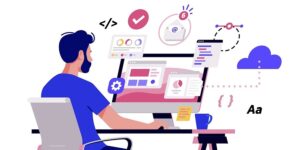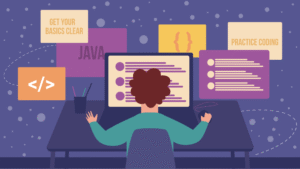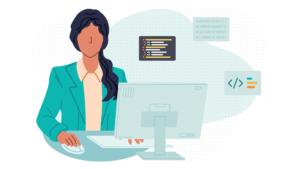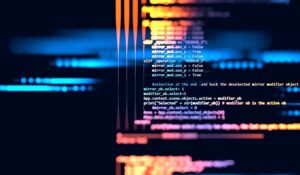How to Become a Successful Programmer?
What do you think makes you successful in any business? Passion, knowledge, or skill? All of these are important, but the most important thing is your passion for a profession. Are you dissatisfied with your current job and thinking about changing careers? You may have seen many advertisements for hiring programmers on job sites. Of course, you have the right to be tempted by the good salary in this profession. However, high salaries and wages will only be awarded to successful and professional programmers. Here, to help you decide in this regard, we will introduce you to the process of becoming a successful programmer.
Who is a programmer?
Programmers are digital architects who dedicate their careers to designing technological features and capabilities. Programming is an astounding profession. Have you ever thought about the backstage of the Internet and wondered how to become a programmer?
Think about all the things you’ve ever done online. If you’re a techie, check your email, scroll through your social media feeds, and check out some of your favorite websites. But have you ever thought about what goes on on these virtual platforms every day?
What is a Robots.txt file, and what is it used for?

Believe it or not, every website, app, and game you flip through in a matter of seconds is the result of weeks or months of programming work.
Programming is a fantastic career with excellent growth potential, mainly since so much of our lives are now conducted online. According to the Bureau of Labor Statistics, the profession is projected to grow by a full 13 percent between 2018 and 2028. That’s more than double the average growth rate expected for other occupations.
According to Payscale, most programmers are happy with their success and are confident in their skills and financial future. The job satisfaction rate is 4.5 (out of 5).
One reason programmers are so satisfied with their jobs is that they are responsible for the virtual architecture and shaping the structures for communication and interaction with their communities in the modern world.
What is the difference between programming and coding?
This question is funny to professionals. They use the terms interchangeably. Coding means writing code, while programming involves several other computer inputs. For example, if your input to a mobile phone is done with gestures, you are programming, not coding. Voice input to devices like Alexa, Siri, and Google Assistant are examples of programming. Don’t be too harsh, though. In most cases, you can use the two terms interchangeably.
Steps to Becoming a Successful Programmer
You can also contribute to this architecture. So follow these steps to succeed in this career:
1. Decide on the industry and market you are interested in.
2. Know the programming languages you need.
3. Start studying at university, technical school, or independently.
4. Start your projects.
5. Start looking for a job.
We will explain each below.
1. Decide on the industry and market you are interested in.
When considering a career as a programmer, first determine the general direction of your career path. Think about why you want to become a coder. That is, where do you want to get to? And what do you want to do?

While most people associate programming with technology, it’s a job that exists in almost every industry. Businesses across every sector need web developers and programmers. A talented coder can find work in everything from artificial intelligence and cybersecurity to social services, healthcare, financial services, and even agriculture.
In 2018, researchers at MyPlan analyzed the employment statistics for programmers across top industries and found a surprising spread across sectors.
While 111,540 programmers worked directly in the scientific, technical, and professional services sectors, a paltry 28,450 worked in the information sector. Another 16,070 were in finance and insurance, 12,710 in manufacturing, and 10,600 in government administration. All of these numbers are expected to grow over the next decade.
So, there are plenty of career options for successful programmers. When thinking about becoming a successful programmer, think about your industry. Don’t limit yourself to one specific niche, though! Ultimately, the skills you gain in this field will be transferable to many different sectors.
2. Know the programming languages you need
You may be familiar with the terms’ front-end’ and ‘back-end’ developers. While their training principles overlap, each requires a specific skill set.
A front-end developer primarily focuses on the part of a website that users interact with. A front-end developer also determines the visual appearance of the site, drives the site’s behavior, and handles its content and structure. Their job is to maximize efficiency, usability, performance, and responsiveness to ensure accessibility for all users.
Back-end developers, as you might expect from the name, work behind the scenes to perform server-side programming. These developers work with libraries, system components, and data structures that users typically do not interact with directly. They ensure an application works properly, while a front-end developer takes care of the application’s appearance.

By determining your inclination towards one or both of these specializations, you will understand which languages and programs you should learn first and prioritize them. Below, we will focus on a comprehensive set of skills that encompass the languages used in both front-end and back-end development.
HTML, CSS, JavaScript
While there are countless programming languages available to any successful developer, they should all know at least one of the front-end languages: HTML, CSS, and JavaScript. These three technologies provide the frameworks for defining the user experience on almost every website. Therefore, they are essential to becoming a successful developer. These languages are necessary for those looking to become web developers.
HTML, or Hypertext Markup Language, is an essential framework for any website today. HTML code defines the structure of a site through “tags” that describe the critical elements of a web page, including text, links, images, and more.
However, when you browse the web, you’ll see a lot of different sites. Much of the magic of web design is made possible through CSS or Cascading Style Sheets. CSS defines and applies the styles of a website, specifying how each aspect of the site is displayed to the viewer.

Finally, JavaScript is the language that powers more interactive websites. When you load a page, you’ll also load JavaScript. This running script allows users to make decisions and take actions, such as searching for a map or booking an appointment. JavaScript also allows for interactive websites by facilitating continuous updates and dynamic interaction with visitors.
Bootstrap
Bootstrap is a widely used, open-source development framework for front-end programming. Programmers use this language to develop responsive websites and applications. This language is significant for developing mobile applications and mobile-centric sites. This aspect of web programming is essential, as more people are accessing the web on their mobile phones than ever before.
Node.js/Express.js
The open-source Node.js environment provides developers with a framework for creating server-side applications using JavaScript. The Node.js environment is designed for use on the server, not in the browser; however, it utilizes regular JavaScript, allowing for easier switching between front-end and back-end tools.

In this regard, Express.js is the most popular web framework for Node. It enables developers to manage web application settings and process data requests using a wide range of libraries, addressing the various needs of websites and interactive applications.
Java
Java and JavaScript are similar in name. However, back-end-oriented Java is significantly different from front-end-oriented JavaScript. Java is a full-fledged, object-oriented programming language with extensive applications. Java can create standalone applications, but JavaScript usually needs to run within an HTML page. Java is also often used for mobile application development.
However, both languages play a fundamental role in the development of functional and user-centric digital platforms.
Git
Git is a version control system. Other software projects rely on this open-source project to track changes and allow hundreds or even thousands of collaborators to contribute.

Without version control software like Git, programmers working on a collaborative project might accidentally save their work over each other’s work and overwrite essential edits.
SQL
Developers use SQL, or Structured Query Language, to manage and edit databases. Much of the web relies on large databases to facilitate interaction and quick access to large amounts of data. SQL is one of the most common languages for database management, and many websites use branded versions of SQL, such as MySQL, to manage their data.
Even if you don’t plan to work extensively with databases, a strong knowledge of SQL is still valuable.
3. Start an academic, technical, or freelance apprenticeship
There are many ways to become a successful programmer and acquire the skills necessary to compete professionally and secure great jobs. The method you choose depends on your specific situation and the resources available to you. The three main ways to learn programming are:
- University
- Private and technical training centers
- Self-study
Consider the time it takes to learn programming skills. If you are starting your career and have some money saved up, you may want to consider a full-time university degree to get into your new career faster. However, if you have family commitments or need a steady income or a full-time job, a part-time or distance learning course at a private and technical training center is a better fit for you.
If you don’t want to enroll in a full-time or part-time training center, use the educational content available on the web yourself. A wide range of text and video content is available in programming education. Many novice programmers have achieved success by learning one or more key programming skills.

Therefore, a wide range of part-time, full-time, in-person, and distance learning opportunities is available to those interested in programming. When you’re mapping out your learning path, consider your timeline and explore different options to find the learning method that best suits your needs.
4. Start your projects
Regardless of the educational path you choose, starting programming projects is a great way to gain experience and develop your skills. You can reference these projects when applying for jobs. Additionally, participating in large-scale programming projects enables you to establish valuable industry connections.
By writing your code and publishing it, you’re putting theoretical knowledge into practice. And you’re turning it into an application. You may not realize it now, but having a portfolio of successful projects will showcase your skills to employers more clearly than any glossy resume.
Working on projects is especially important for self-taught learners, who often lack the same opportunities to complete classroom projects as their peers.
How to Run Android Apps on Windows 11?
Some of these projects include:
- Designing a website for yourself
- Developing a simple mobile app, such as a weather app
- Redesigning and repurposing one of your favorite apps with your changes.
5. Start looking for a job
Finding a job in programming is much like finding a job in any other profession. You’ll need to create a resume, gather your professional references, and make one or more work samples publicly available. Registering on remote work and job sites like Carlancer will also help you find new job opportunities. Attending programming conferences and events will also help you develop connections and better understand the industry.

Additionally, you should practice your interviewing and personal development skills to effectively handle interviews, work in teams, and interact with various employers and clients.
The market for this profession is hot, but remember that finding the proper programming job depends on your location and current needs, and it may take several months. Below, we will point out some misconceptions about becoming a successful programmer.
Five misconceptions about becoming a successful programmer
1: You need excellent knowledge of mathematics. Not true. People with average math skills have also worked as successful programmers.
2: Programming is for geniuses. Again, this is false. You can become an expert in programming, just like any other skill, with the necessary study and practice. Programming is not an innate talent but can be learned.
3: Women do not make good programmers. This is also a rumor. Some of the top executives in the industry who lead large programming teams are women. Women can program as well as men, if not better.

4: You need a degree to become a successful programmer. It’s not necessary. Numerous resources and courses are available online, making it easy for anyone to learn programming. The designers of these resources and courses are experts in the field of programming.
5: Programming is boring. It’s not at all. When the result of your work is helpful in people’s lives, you will find more motivation to learn and plan in this field.
Finally
To become a successful programmer, first of all, consider your interest in this profession. Then, you should examine the industry, programming language, and the skills required to work in the programming field. The time and method of learning this skill are also significant. What are your thoughts on learning and succeeding in this profession?
Hi.can i be a programmer even if i am not techie? I already quit my job and i am looking for something to do. Ty